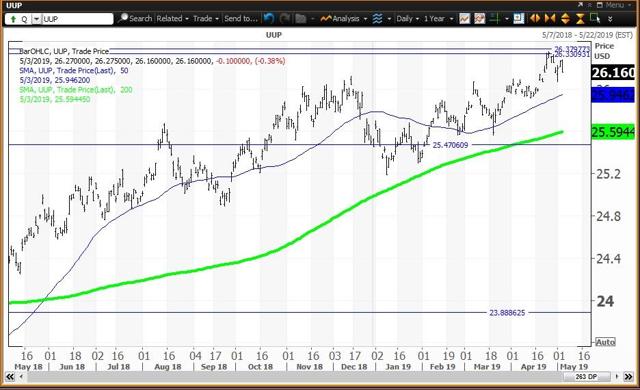[ad_1]
Here are the daily charts for the gold, commodities and the dollar ETFs.
The gold trust ETF tracks the spot price of gold and is said to be backed by gold bars in vaults in London.
SPDR Gold Trust (NYSEARCA:GLD)
 Courtesy of Refinitiv XENITH
Courtesy of Refinitiv XENITH
The Gold ETF ($120.65 on May 3) is down 0.5% so far in 2019 and is 8.6% above its Aug. 15 low of $111.06. GLD is trading between its 200-day simple moving average at $118.37 and its 50-day simple moving average at $122.34. Beware that the weekly chart is negative with the “reversion to the mean” at $118.37. The 12x3x3 weekly slow stochastic reading fell to 20.24 last week down from 23.47 on April 26.
Investor Strategy: Buy weakness to the 200-week SMA at $118.37 and reduce holdings on strength to a quarterly pivot at $122.55 and its monthly risky level at $126.01. My semiannual pivot at $120.36 will remain a magnet.
The commodity ETF is heavily-weighted to energy by about 60%.
iShares S&P GSCI Commodity-Indexed Trust ETF (NYSEARCA:GSG)
 Courtesy of Refinitiv XENITH
Courtesy of Refinitiv XENITH
The Commodities ETF ($116.17 on May 3) is up 15.3% so far in 2019 and up 19.8% since its Dec. 26 low of $13.50 thanks mainly to the strength in Nymex crude oil. Crude oil is sliding recently as a drag on GSG. This ETF is down 14% from its Oct. 3 high of $18.81. GSG is below its 200-day simple moving average at $16.29 with its quarterly risky level at $17.13. The weekly chart is positive but overbought with the 200-week simple moving average or “reversion to the mean” at $15.61. The 12x3x3 weekly slow stochastic reading slipped to 86.32 last week down from 90.87 on April 26 when commodities were in an “inflating parabolic bubble” formation.
Investor Strategy: Buy GSG on weakness to its 200-week SMA at $15.61 and reduce holdings on strength to its quarterly risky level at $17.13. My monthly value level lags at $14.53.
The weekly chart for Nymex crude oil ($61.94 on May 3) is positive but overbought with its weekly stochastic reading falling below 90.00 as an “inflating parabolic bubble” to 88.33 on May 3, still above the overbought threshold of 80.00. Semiannual and monthly value levels are $50.84 and $48.52, respectively, with weekly and quarterly risky levels at $67.33 and $68.52, respectively.
The US Dollar ETF is a basket of currencies that includes the dollar vs. Euro, Japanese Yen, British Pound, Canadian Dollar, Swedish Krona and Swiss Franc.
PowerShares DB US Dollar Index Bullish ETF (NYSEARCA:UUP)
 Courtesy of Refinitiv XENITH
Courtesy of Refinitiv XENITH
The Dollar ETF ($26.16 on May 3) is up 2.8% so far in 2019 and up 13.1% since trading as low as $23.12 in early-2018. UUP is above its 50-day and 200-day simple moving averages at $25.95 and $25.59, respectively. The weekly chart is positive but overbought with its “reversion to the mean” at $25.06. The latest multiyear high is $26.83 set during the week of Jan. 6, 2017. The 12x3x3 weekly slow stochastic reading ended last week at 88.29 up from 87.40 on April. 26.
Investor Strategy: Buy weakness to annual and quarterly value levels at $25.47 and $23.89, respectively, and reduce holdings on strength to monthly and semiannual risky levels at $26.33 and $26.39, respectively.
How to use my value levels and risky levels:
Value levels and risky levels are based upon the last nine weekly, monthly, quarterly, semiannual and annual closes. The first set of levels was based upon the closes on Dec. 31. The original semiannual and annual levels remain in play. The weekly level changes each week; the monthly level was changed at the end of January, February, March and April. The quarterly level was changed at the end of March. My theory is that nine years of volatility between closes are enough to assume that all possible bullish or bearish events for the stock are factored in. To capture share price volatility investors should buy on weakness to a value level and reduce holdings on strength to a risky level. A pivot is a value level or risky level that was violated within its time horizon. Pivots act as magnets that have a high probability of being tested again before its time horizon expires.
How to use 12x3x3 Weekly Slow Stochastic Readings:
My choice of using 12x3x3 weekly slow stochastic readings was based upon back-testing many methods of reading share-price momentum with the objective of finding the combination that resulted in the fewest false signals. I did this following the stock market crash of 1987, so I have been happy with the results for more than 30 years. The stochastic reading covers the last 12 weeks of highs, lows and closes for the stock. There is a raw calculation of the differences between the highest high and lowest low versus the closes. These levels are modified to a fast reading and a slow reading and I found that the slow reading worked the best. The stochastic reading scales between 00.00 and 100.00 with readings above 80.00 considered overbought and readings below 20.00 considered oversold. Recently I noted that stocks tend to peak and decline 10% to 20% and more shortly after a reading rises above 90.00, so I call that an “inflating parabolic bubble” as a bubble always pops. I also call a reading below 10.00 as being “too cheap to ignore.”
Disclosure: I/we have no positions in any stocks mentioned, and no plans to initiate any positions within the next 72 hours. I wrote this article myself, and it expresses my own opinions. I am not receiving compensation for it (other than from Seeking Alpha). I have no business relationship with any company whose stock is mentioned in this article.
[ad_2]
Source link Google News

